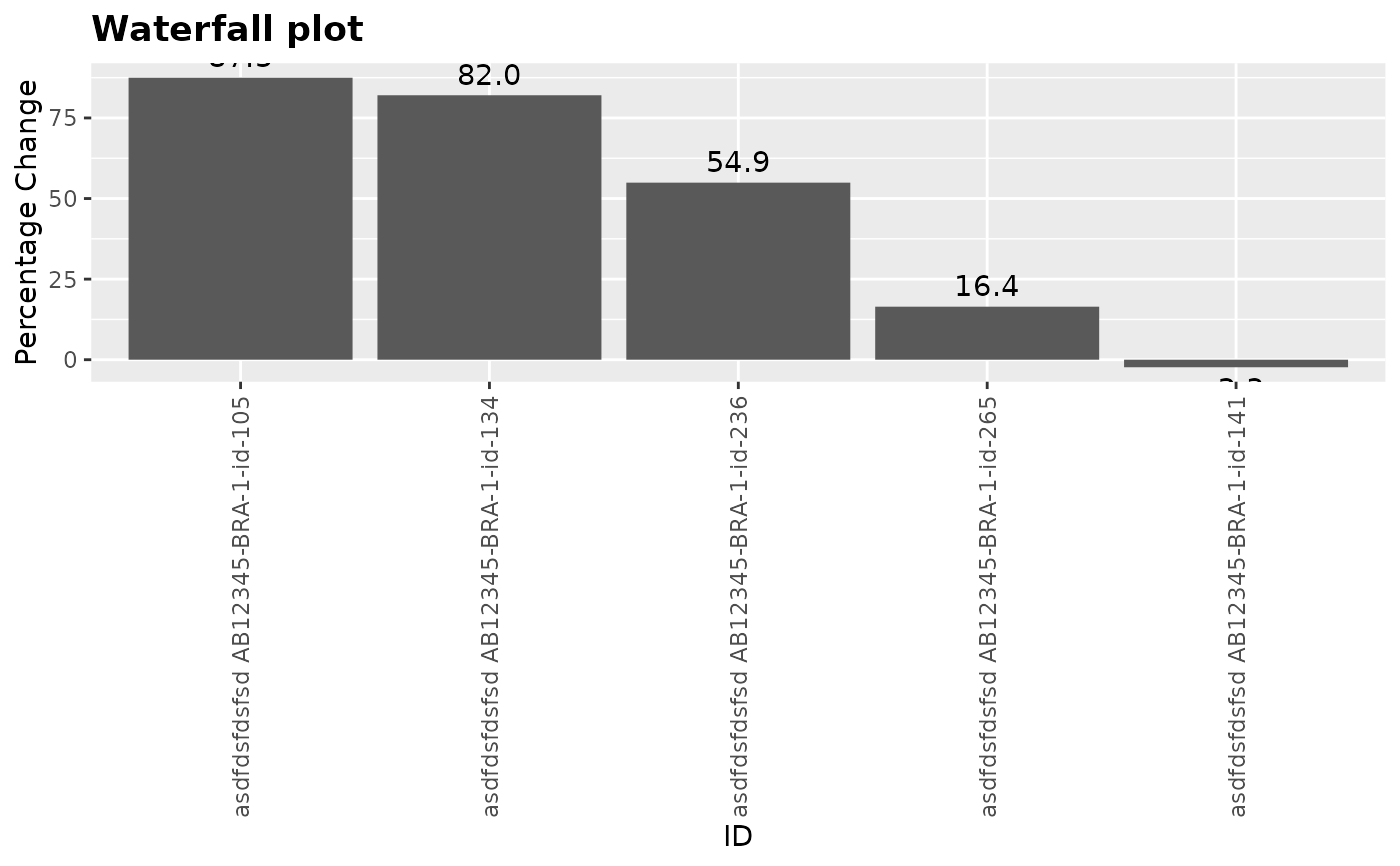Usage
g_waterfall(
height,
id,
col_var = NULL,
col = getOption("ggplot2.discrete.colour"),
xlab = NULL,
ylab = NULL,
col_legend_title = NULL,
title = NULL
)Arguments
- height
(
numericvector)
Contains values to be plotted as the waterfall bars- id
(vector)
Contains of IDs used as the x-axis label for the waterfall bars- col_var
(
factor,characterorNULL)
Categorical variable for bar coloring.NULLby default.- col
(
character)
colors.- xlab
(
charactervalue)
x label. Default isID.- ylab
(
charactervalue)
y label. Default isValue.- col_legend_title
(
charactervalue)
Text to be displayed as legend title.- title
(
charactervalue)
Text to be displayed as plot title.
Author
Yuyao Song (songy) yuyao.song@roche.com
Examples
library(nestcolor)
g_waterfall(height = c(3, 5, -1), id = letters[1:3])
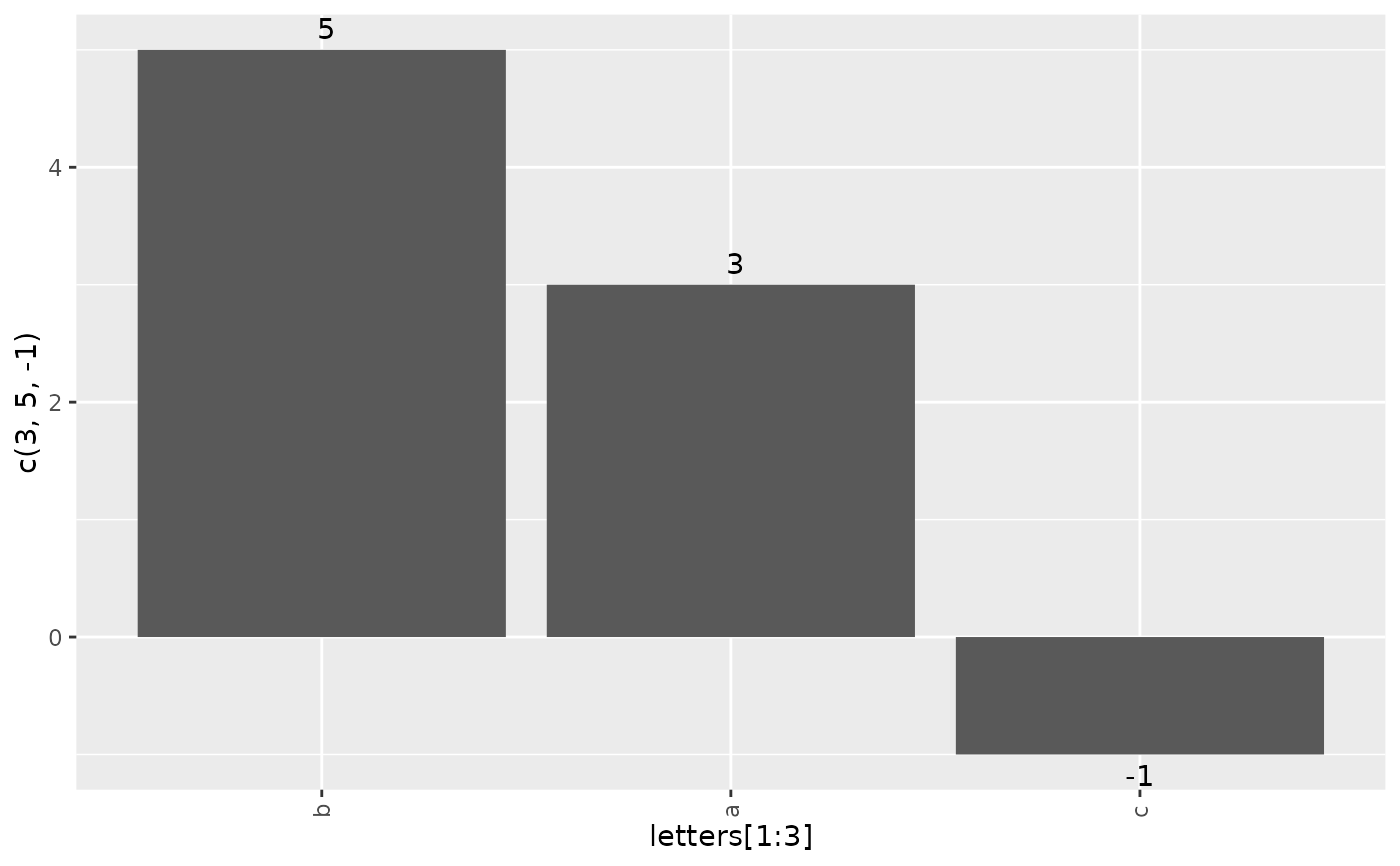 g_waterfall(
height = c(3, 5, -1),
id = letters[1:3],
col_var = letters[1:3]
)
g_waterfall(
height = c(3, 5, -1),
id = letters[1:3],
col_var = letters[1:3]
)
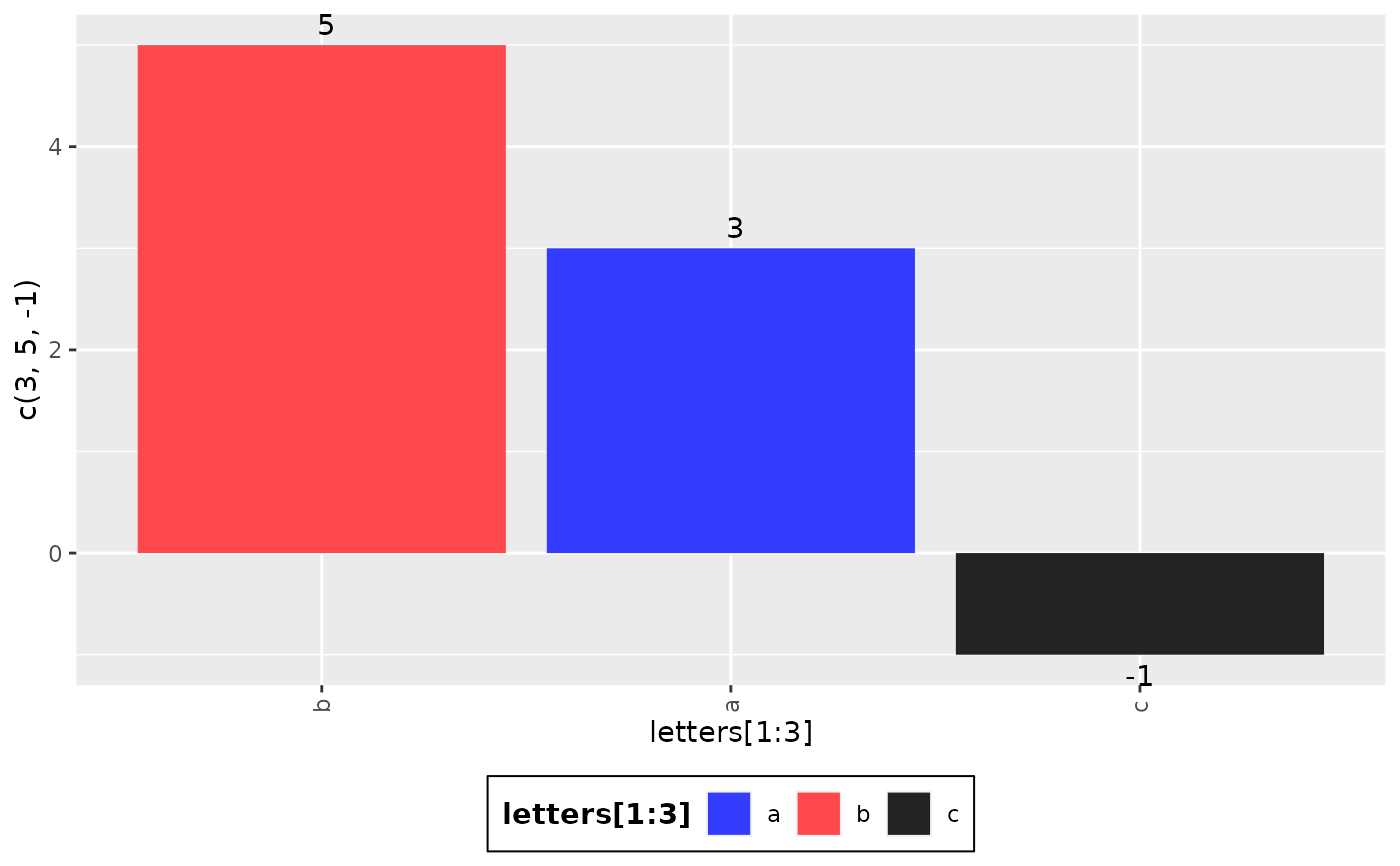 library(scda)
library(dplyr)
ADSL <- synthetic_cdisc_data("latest")$adsl
ADSL_f <- ADSL %>%
select(USUBJID, STUDYID, ARM, ARMCD, SEX)
ADRS <- synthetic_cdisc_data("latest")$adrs
ADRS_f <- ADRS %>%
filter(PARAMCD == "OVRINV") %>%
mutate(pchg = rnorm(n(), 10, 50))
ADRS_f <- head(ADRS_f, 30)
ADRS_f <- ADRS_f[!duplicated(ADRS_f$USUBJID), ]
head(ADRS_f)
#> # A tibble: 5 × 56
#> STUDYID USUBJID SUBJID SITEID AGE AGEU SEX RACE ETHNIC COUNTRY DTHFL
#> <chr> <chr> <chr> <chr> <int> <fct> <fct> <fct> <fct> <fct> <fct>
#> 1 AB12345 AB12345-BR… id-105 BRA-1 38 YEARS M BLAC… UNKNO… BRA Y
#> 2 AB12345 AB12345-BR… id-134 BRA-1 47 YEARS M WHITE NOT H… BRA Y
#> 3 AB12345 AB12345-BR… id-141 BRA-1 35 YEARS F WHITE HISPA… BRA N
#> 4 AB12345 AB12345-BR… id-236 BRA-1 32 YEARS M BLAC… NOT H… BRA N
#> 5 AB12345 AB12345-BR… id-265 BRA-1 25 YEARS M WHITE NOT H… BRA Y
#> # … with 45 more variables: INVID <chr>, INVNAM <chr>, ARM <fct>, ARMCD <fct>,
#> # ACTARM <fct>, ACTARMCD <fct>, TRT01P <fct>, TRT01A <fct>, REGION1 <fct>,
#> # STRATA1 <fct>, STRATA2 <fct>, BMRKR1 <dbl>, BMRKR2 <fct>, ITTFL <fct>,
#> # SAFFL <fct>, BMEASIFL <fct>, BEP01FL <fct>, AEWITHFL <fct>, RANDDT <date>,
#> # TRTSDTM <dttm>, TRTEDTM <dttm>, EOSSTT <fct>, EOTSTT <fct>, EOSDT <date>,
#> # EOSDY <int>, DCSREAS <fct>, DTHDT <date>, DTHCAUS <fct>, DTHCAT <fct>,
#> # LDDTHELD <int>, LDDTHGR1 <fct>, LSTALVDT <date>, DTHADY <int>, …
#> # ℹ Use `colnames()` to see all variable names
g_waterfall(
height = ADRS_f$pchg,
id = ADRS_f$USUBJID,
col_var = ADRS_f$AVALC
)
library(scda)
library(dplyr)
ADSL <- synthetic_cdisc_data("latest")$adsl
ADSL_f <- ADSL %>%
select(USUBJID, STUDYID, ARM, ARMCD, SEX)
ADRS <- synthetic_cdisc_data("latest")$adrs
ADRS_f <- ADRS %>%
filter(PARAMCD == "OVRINV") %>%
mutate(pchg = rnorm(n(), 10, 50))
ADRS_f <- head(ADRS_f, 30)
ADRS_f <- ADRS_f[!duplicated(ADRS_f$USUBJID), ]
head(ADRS_f)
#> # A tibble: 5 × 56
#> STUDYID USUBJID SUBJID SITEID AGE AGEU SEX RACE ETHNIC COUNTRY DTHFL
#> <chr> <chr> <chr> <chr> <int> <fct> <fct> <fct> <fct> <fct> <fct>
#> 1 AB12345 AB12345-BR… id-105 BRA-1 38 YEARS M BLAC… UNKNO… BRA Y
#> 2 AB12345 AB12345-BR… id-134 BRA-1 47 YEARS M WHITE NOT H… BRA Y
#> 3 AB12345 AB12345-BR… id-141 BRA-1 35 YEARS F WHITE HISPA… BRA N
#> 4 AB12345 AB12345-BR… id-236 BRA-1 32 YEARS M BLAC… NOT H… BRA N
#> 5 AB12345 AB12345-BR… id-265 BRA-1 25 YEARS M WHITE NOT H… BRA Y
#> # … with 45 more variables: INVID <chr>, INVNAM <chr>, ARM <fct>, ARMCD <fct>,
#> # ACTARM <fct>, ACTARMCD <fct>, TRT01P <fct>, TRT01A <fct>, REGION1 <fct>,
#> # STRATA1 <fct>, STRATA2 <fct>, BMRKR1 <dbl>, BMRKR2 <fct>, ITTFL <fct>,
#> # SAFFL <fct>, BMEASIFL <fct>, BEP01FL <fct>, AEWITHFL <fct>, RANDDT <date>,
#> # TRTSDTM <dttm>, TRTEDTM <dttm>, EOSSTT <fct>, EOTSTT <fct>, EOSDT <date>,
#> # EOSDY <int>, DCSREAS <fct>, DTHDT <date>, DTHCAUS <fct>, DTHCAT <fct>,
#> # LDDTHELD <int>, LDDTHGR1 <fct>, LSTALVDT <date>, DTHADY <int>, …
#> # ℹ Use `colnames()` to see all variable names
g_waterfall(
height = ADRS_f$pchg,
id = ADRS_f$USUBJID,
col_var = ADRS_f$AVALC
)
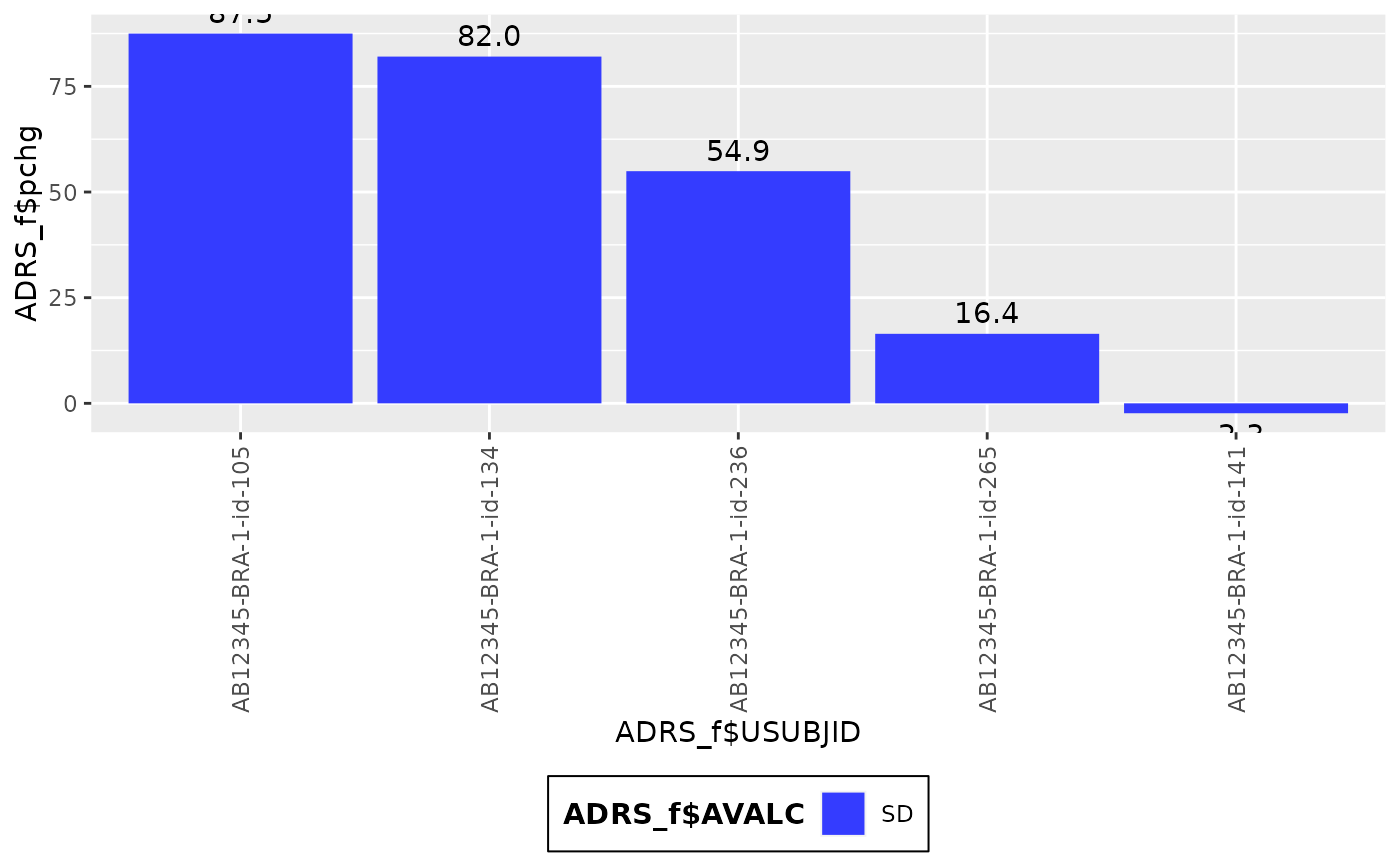 g_waterfall(
height = ADRS_f$pchg,
id = paste("asdfdsfdsfsd", ADRS_f$USUBJID),
col_var = ADRS_f$SEX
)
g_waterfall(
height = ADRS_f$pchg,
id = paste("asdfdsfdsfsd", ADRS_f$USUBJID),
col_var = ADRS_f$SEX
)
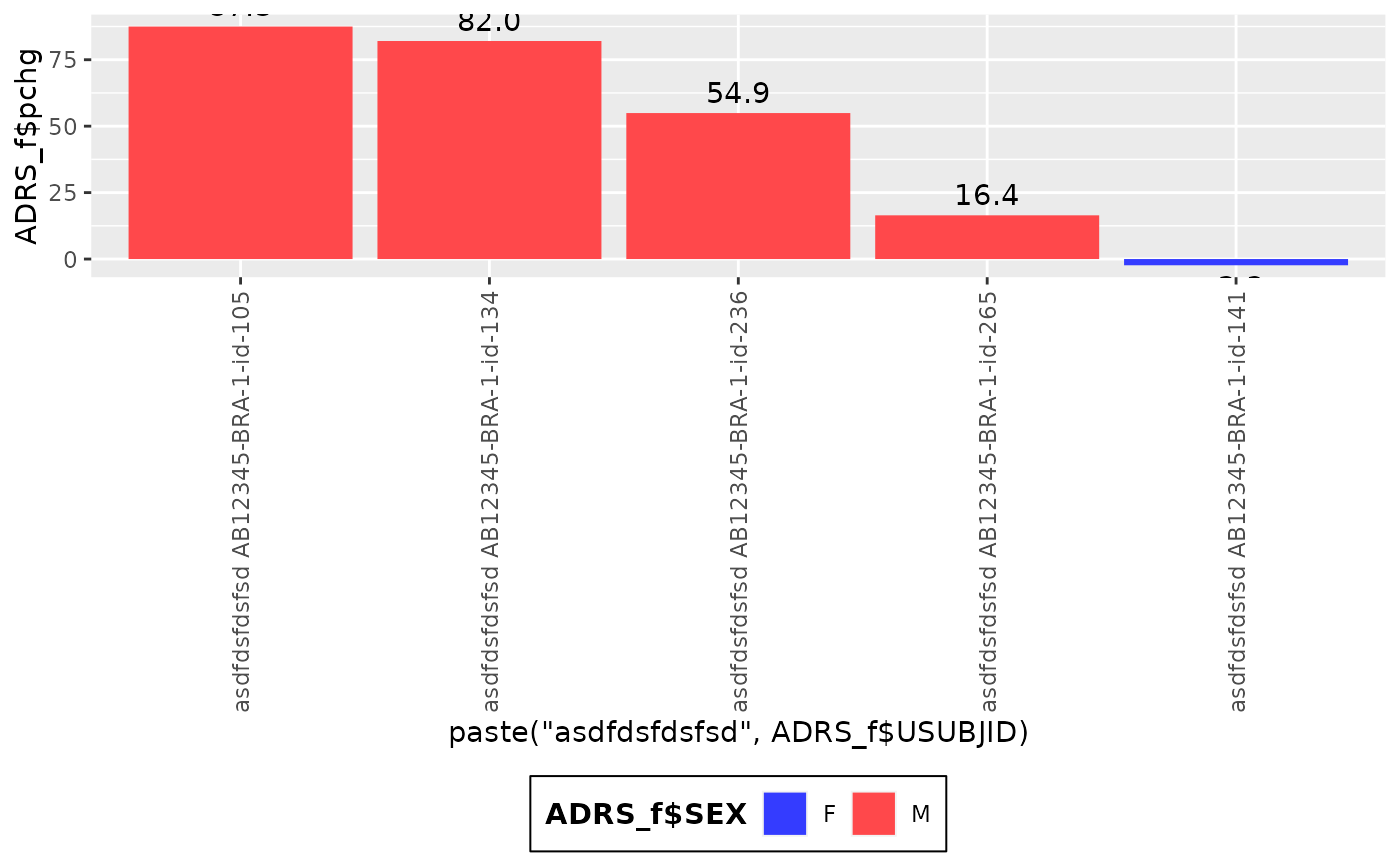 g_waterfall(
height = ADRS_f$pchg,
id = paste("asdfdsfdsfsd", ADRS_f$USUBJID),
xlab = "ID",
ylab = "Percentage Change",
title = "Waterfall plot"
)
g_waterfall(
height = ADRS_f$pchg,
id = paste("asdfdsfdsfsd", ADRS_f$USUBJID),
xlab = "ID",
ylab = "Percentage Change",
title = "Waterfall plot"
)
